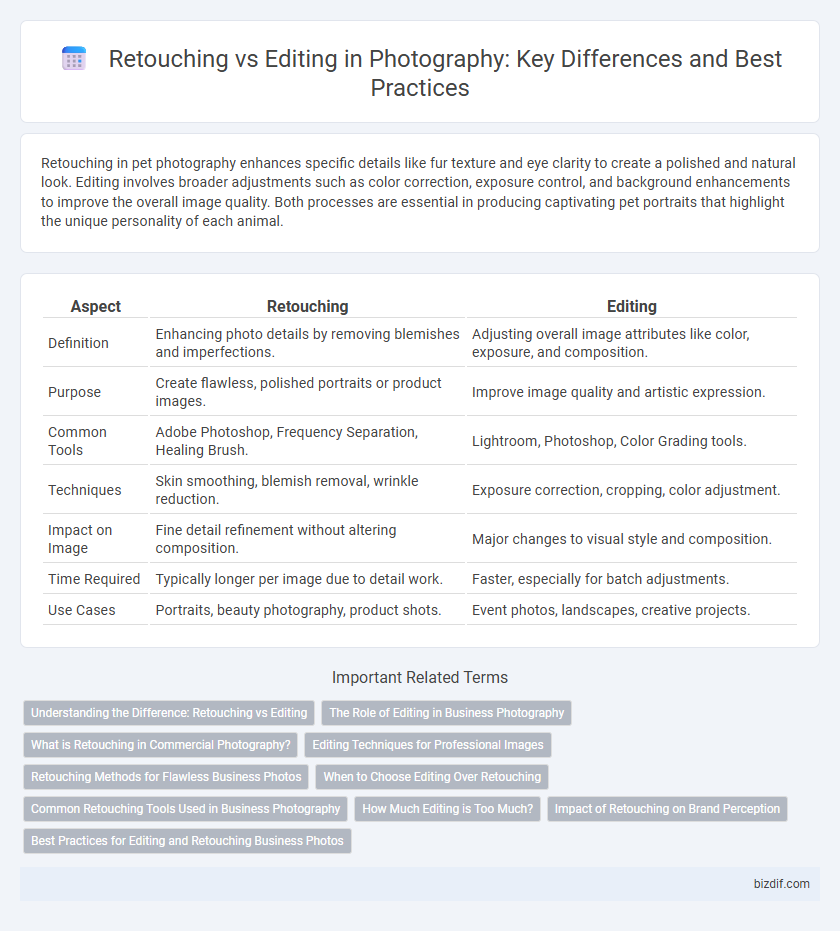Retouching in pet photography enhances specific details like fur texture and eye clarity to create a polished and natural look. Editing involves broader adjustments such as color correction, exposure control, and background enhancements to improve the overall image quality. Both processes are essential in producing captivating pet portraits that highlight the unique personality of each animal.
Table of Comparison
| Aspect | Retouching | Editing |
|---|---|---|
| Definition | Enhancing photo details by removing blemishes and imperfections. | Adjusting overall image attributes like color, exposure, and composition. |
| Purpose | Create flawless, polished portraits or product images. | Improve image quality and artistic expression. |
| Common Tools | Adobe Photoshop, Frequency Separation, Healing Brush. | Lightroom, Photoshop, Color Grading tools. |
| Techniques | Skin smoothing, blemish removal, wrinkle reduction. | Exposure correction, cropping, color adjustment. |
| Impact on Image | Fine detail refinement without altering composition. | Major changes to visual style and composition. |
| Time Required | Typically longer per image due to detail work. | Faster, especially for batch adjustments. |
| Use Cases | Portraits, beauty photography, product shots. | Event photos, landscapes, creative projects. |
Understanding the Difference: Retouching vs Editing
Retouching involves enhancing specific elements within a photograph, such as skin smoothing, blemish removal, or color correction, to improve the overall aesthetic without altering the original content. Editing encompasses broader adjustments, including cropping, exposure changes, and compositional modifications, aiming to refine the image's structure and visual impact. Understanding the difference between retouching and editing is crucial for photographers seeking to maintain the integrity of their images while enhancing visual appeal.
The Role of Editing in Business Photography
Editing enhances business photography by refining images to align with brand identity and marketing goals. Precise adjustments in color balance, exposure, and composition create polished visuals that attract target audiences and communicate professionalism. Effective editing ensures consistency across campaigns, boosting brand recognition and engagement.
What is Retouching in Commercial Photography?
Retouching in commercial photography involves enhancing images by removing imperfections, smoothing skin, and adjusting details to achieve a flawless, polished look. This precise technique focuses on altering specific areas without changing the overall composition, ensuring product appeal and brand consistency. Retouching enhances visual impact, making photos more compelling for advertising and promotional materials.
Editing Techniques for Professional Images
Editing techniques for professional images encompass a range of processes including color correction, exposure adjustment, and sharpening to enhance overall image quality. Advanced methods like layer masking, frequency separation, and non-destructive editing using software such as Adobe Photoshop and Lightroom allow precise control over image details while preserving original file integrity. Mastery of these techniques ensures polished, visually compelling photographs tailored to commercial and artistic standards.
Retouching Methods for Flawless Business Photos
Retouching methods for flawless business photos involve precise skin smoothing, blemish removal, and enhancing facial features to create a polished and professional appearance. Techniques such as frequency separation, dodge and burn, and color correction help achieve natural-looking results while maintaining texture and detail. These targeted adjustments ensure business portraits convey confidence and approachability, essential for corporate branding and marketing.
When to Choose Editing Over Retouching
Editing should be chosen over retouching when the goal is to enhance the overall composition, adjust color balance, or correct exposure issues in photography. It involves altering the image's basic elements, such as brightness, contrast, saturation, and cropping, to improve the photo's visual impact. Editing is essential for addressing technical imperfections and creating a balanced, visually appealing final image before applying fine retouching techniques.
Common Retouching Tools Used in Business Photography
Common retouching tools used in business photography include Adobe Photoshop, Lightroom, and Capture One, which enable precise adjustments to enhance image quality. These tools offer features like skin smoothing, blemish removal, color correction, and sharpening to create polished, professional portraits. Utilizing advanced brushes, layers, and masks allows retouchers to maintain natural textures while perfecting the final image appearance.
How Much Editing is Too Much?
Excessive photo retouching can lead to unnatural images that distort reality and reduce authenticity, often creating unrealistic expectations. Editing should enhance the subject by correcting flaws and improving composition while maintaining the integrity of the original scene. Striking the right balance ensures that images remain visually appealing without appearing over-manipulated or artificial.
Impact of Retouching on Brand Perception
Retouching enhances brand perception by creating flawless, polished images that communicate professionalism and attention to detail, which can increase consumer trust and loyalty. High-quality retouching eliminates distractions and imperfections, allowing the core message and aesthetic of the brand to shine through vividly. This process plays a crucial role in shaping the visual identity and perceived value of products or services in photography-based marketing campaigns.
Best Practices for Editing and Retouching Business Photos
Effective photo editing enhances image quality by adjusting exposure, contrast, and color balance to create a polished and professional look. Retouching focuses on removing imperfections such as blemishes, stray hairs, and background distractions to present a flawless final product. Combining precise editing and retouching techniques ensures business photos convey brand professionalism and appeal to target clients.
Retouching vs Editing Infographic

 bizdif.com
bizdif.com